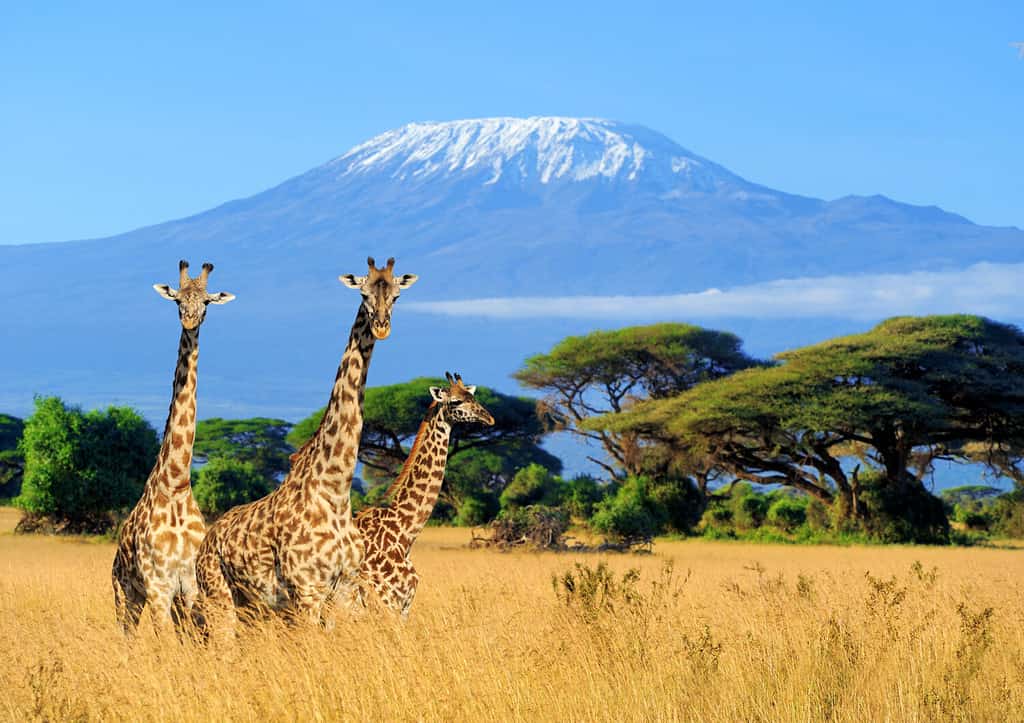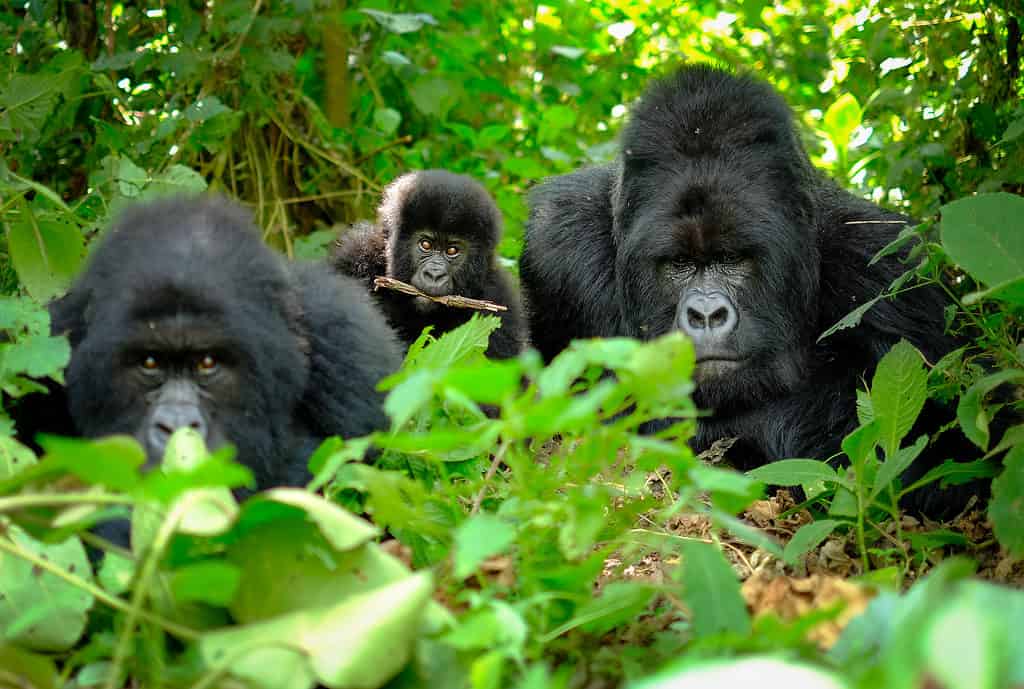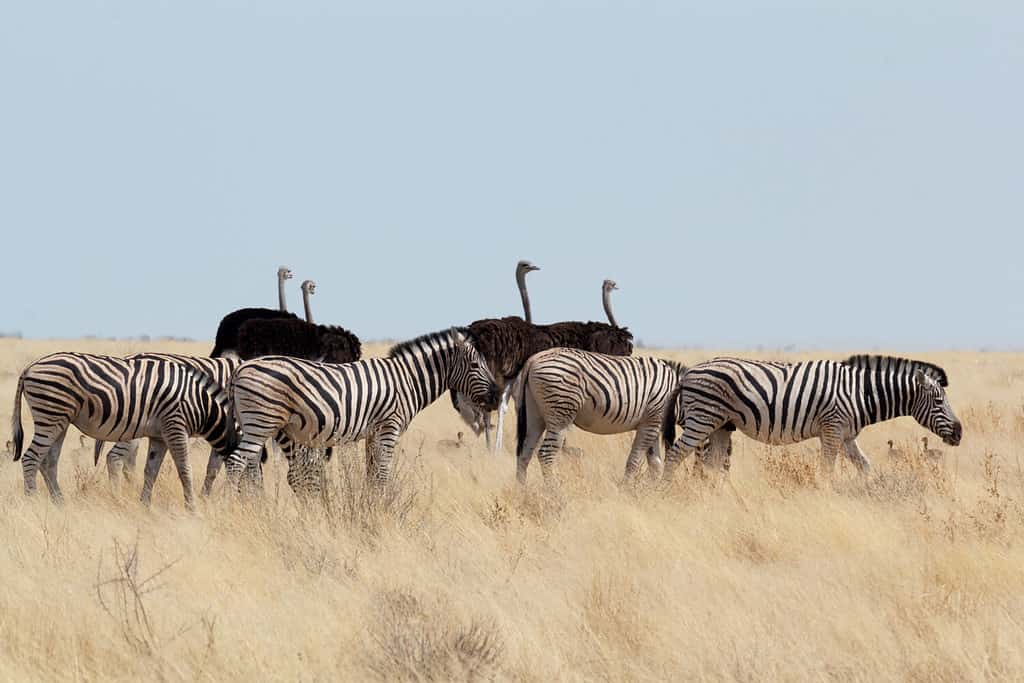Africa is a continent of diverse landscapes, and among its natural wonders are some of the largest volcanoes on Earth. These majestic volcanic giants have shaped the African terrain and continue to capture the fascination of geologists and adventurers alike.
In this article, we’ll delve into the largest volcanoes in Africa, revealing their awe-inspiring dimensions and determining which ones still pose an active threat.
1. Mount Kilimanjaro: Africa’s Highest Volcano

Wildlife, such as these giraffes, is abundant on the plains around Mount Kilimanjaro.
©Volodymyr Burdiak/Shutterstock.com
Soaring 19,341 feet above sea level, Mount Kilimanjaro stands as Africa’s tallest volcano. It’s not active; the last major eruption occurred 360,000 years ago.
Mount Kilimanjaro’s formation is closely tied to the tectonic forces that have shaped the East African region over millions of years.
Kilimanjaro is a stratovolcano, which means it’s characterized by its conical shape formed from successive layers of volcanic ash, lava, and other volcanic debris.
The main geological forces responsible for Kilimanjaro’s rise are the East African Rift and a hot spot beneath the Earth’s crust. The East African Rift is a tectonic plate boundary where the African continent is slowly splitting apart.
The hot spot beneath Kilimanjaro, similar to the one responsible for the Hawaiian Islands, has been a constant source of volcanic activity. Molten rock, or magma, rises through the Earth’s crust due to the hot spot’s influence.
Over time, this repeated cycle of magma ascent and volcanic eruptions has built the mountain to its towering height.
Kilimanjaro is unique not only for its size but also for the fact that it is a free-standing volcano, not part of a volcanic range. This sets it apart from other volcanic peaks around the world. The mountain’s summit is crowned by glaciers, although these ice fields have been receding over recent decades due to climate change.
While Kilimanjaro is currently dormant and not considered an active volcano, its geological history is a testament to the ever-changing landscape of Africa.
2. Mount Kenya: Africa’s Second Highest Volcano

View of Mount Kenya through the clouds.
©Wijnand vT/Shutterstock.com
Mount Kenya, at 17,057 feet, is Africa’s second-highest volcanic peak. It’s also inactive, with its last eruption dating back about 3 million years.
One of the most remarkable aspects of Mount Kenya is its snow-capped peaks, despite being situated near the equator. Its high elevation, at over 17,000 feet, allows for the formation of glaciers and icefields.
Mount Kenya’s unique topography encompasses several distinct climate zones as you ascend the mountain. The lower slopes feature lush, dense forests, while higher elevations give way to moorland.
Mt. Kenya is a UNESCO World Heritage Site.
Mount Kenya has three main peaks: Batian, Nelion, and Lenana. Batian is the highest and is known for its challenging technical climbs. Nelion is slightly lower but also a popular climbing destination. Point Lenana is the most accessible of the three, and it is often the goal for trekkers who don’t have advanced climbing skills.
The Kikuyu people, the indigenous people living in the area, consider the mountain to be a sacred place, and it plays a central role in their mythology and traditions.
Conservation efforts in the area include preservation of endangered species, such as the mountain bongo antelope and various bird species.
3. Simien Mountains: The Roof of Africa
Known as the “Roof of Africa,” the Simien Mountains in Ethiopia have ancient volcanic origins, yet they’ve been dormant for millions of years.
4. Mount Elgon: An Extinct Giant
Mount Elgon, straddling the border between Uganda and Kenya, reaches 14,177 feet. Classified as extinct, its last volcanic activity occurred over 24,000 years ago.
5. Mount Nyiragongo: Africa’s Most Active Volcano
In the Democratic Republic of the Congo, Mount Nyiragongo ranks as one of Africa’s most active volcanoes. Its last eruption was in 2021, indicating an ongoing threat.
For the latest updates on Mount Nyiragongo’s activity, visit Volcano Discovery.
6. Erta Ale: The Lava Lake Volcano

The nightglow of Erta Ale, Ethiopia, Africa.
©Michail_Vorobyev/Shutterstock.com
Nestled in the Danakil Depression of Ethiopia, Erta Ale boasts one of the world’s few continuously active lava lakes, making it an active threat.
To see the mesmerizing lava lake at Erta Ale, check out this video by National Geographic.
7. Mount Cameroon: Africa’s Most Active Stratovolcano
Mount Cameroon, standing at 13,435 feet, is Africa’s most active stratovolcano, erupting over 20 times in the last century.
A stratovolcano, also known as a composite volcano, is a type of volcano characterized by its steep, conical shape and a structure formed from multiple layers of volcanic material.
Stratovolcanoes are one of the most common types of volcanoes on Earth and are associated with explosive eruptions.
For more information on Mount Cameroon’s activity, visit the Global Volcanism Program.
8. The Virunga Mountains: Home to Africa’s Mountain Gorillas

Gorillas are the biggest primates on earth. This family of gorillas live in the Virunga Mountains.
©Marian Galovic/Shutterstock.com
Straddling Uganda, Rwanda, and the Democratic Republic of the Congo, the Virunga Mountains are volcanic, with Mount Mikeno remaining dormant.
This region is famous for its remarkable biodiversity and is particularly known for being the habitat of the endangered mountain gorillas. These magnificent primates are among the world’s most endangered animals, with only a few hundred individuals left in the wild.
The Virunga Mountains are not just home to mountain gorillas. They also harbor a diverse range of other wildlife, including golden monkeys, forest elephants, chimpanzees, and a wide variety of bird species. The area is a biodiversity hotspot, with many endemic species found nowhere else in the world.
The high-altitude forests of the Virunga Mountains have their own unique flora, including various rare and endemic plant species. The bamboo and Hagenia forests that cover the mountains provide vital food and shelter for the gorillas and other wildlife.
The volcanic soil is the result of past eruptions, making the mountains an example of the intricate relationship between geological processes and ecosystems.
The Virunga Mountains are part of a UNESCO World Heritage Site.
9. The East African Rift: A Volcanic Hotspot

Zebra and ostrich graze in the region around the East African Rift.
©Artush/Shutterstock.com
The East African Rift is a geological hotspot responsible for many of Africa’s volcanoes, an active region where continental plates are pulling apart.
This geological feature has had a profound impact on the biodiversity and natural processes of East Africa.
The East African Rift is home to a wide variety of habitats, including mountains, lakes, savannas, and forests. This diversity of landscapes supports a rich array of plant and animal species. The rift region is considered a biodiversity hotspot, with many endemic species that are found nowhere else on Earth.
The rift area is famous for its stunning freshwater lakes, including Lake Victoria, Lake Tanganyika, and Lake Malawi. These lakes are home to unique aquatic species like the cichlid fish.
The rift region acts as a migratory corridor for wildlife, facilitating the movement of large mammals such as wildebeests, zebras, and elephants. These migrations are among the most spectacular wildlife events in the world.
The East African Rift is a living laboratory for studying the complex interplay between geological and ecological processes.
10. Volcanoes Beneath the Sahara: An Ancient History
The Sahara Desert holds evidence of ancient volcanic activity, with several buried calderas. These volcanoes have been extinct for millions of years.
11. The Canary Islands: African Volcanoes in the Atlantic
Off Africa’s northwest coast, the Canary Islands are volcanic in origin, featuring both active and dormant volcanoes, with recent eruptions on La Palma.
For the latest news on the Canary Islands’ volcanic activity, visit Involcan.
12. Mount Ruapehu: A New Zealand Connection in Africa
Did you know volcanoes link New Zealand and Africa?
Mount Ruapehu (actually located in New Zealand) is linked to Africa’s geological history, part of the global volcanic activity showcased by the Pacific Ring of Fire.
This chart will help you visualize Africa’s many volcanoes.
Africa’s Volcanoes
| Volcano | Elevation | Status |
| Mount Kilimanjaro | 19,341 ft (5,895 m) | Inactive |
| Mount Kenya | 17,057 ft (5,199 m) | Inactive |
| Simien Mountains | Varies (Rooftop of Africa) | Inactive |
| Mount Elgon | 14,177 ft (4,321 m) | Inactive |
| Mount Nyiragongo | 11,385 ft (3,470 m) | Active |
| Erta Ale | Varies (Lava Lake) | Active |
| Mount Cameroon | 13,435 ft (4,095 m) | Active |
| Mount Ruapehu | 9,176 ft (2,797 m) (Not in Africa) | Inactive |
| Virunga Mountains | Varies | Inactive/Dormant |
| Sahara Calderas | Varies | Extinct |
| Canary Islands | Varies | Active/Dormant |
Africa’s largest volcanoes are a testament to the continent’s dynamic geological history. While some, like Mount Kilimanjaro and Mount Kenya, have long ceased their volcanic activities, others, like Mount Nyiragongo, Erta Ale, and Mount Cameroon, continue to pose an active threat.
Whether you’re a geology lover or an adventurous traveler, exploring Africa’s largest volcanoes provides an opportunity to witness the Earth’s raw power and beauty in action.
Stay updated on Africa’s volcanic activity, and ensure you’re well-prepared for your adventure, as these dynamic geological wonders continue to shape the continent’s ever-evolving landscape.
So, put on your hiking boots, pack your gear, and embark on a journey to discover these magnificent volcanic giants.
The photo featured at the top of this post is © TristanBalme/Shutterstock.com
Thank you for reading! Have some feedback for us? Contact the AZ Animals editorial team.







